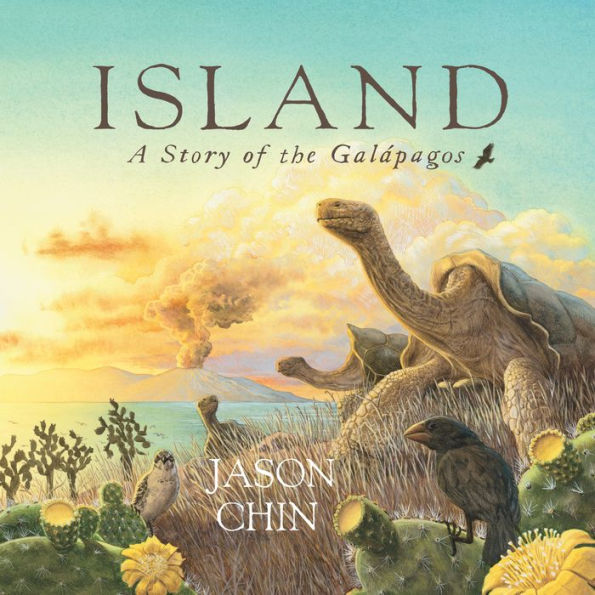Publishers Weekly
Chin (Coral Reefs) does more than just explain how species of reptiles and birds on the Galapagos have evolved. He begins with the birth of the islands themselves, a process in which volcanic eruptions punch successive holes in the Earth’s surface as tectonic plates move over them. Set against changes in the islands’ climate and geology over many millennia, the adaptations of the islands’ animals take on new significance. Many explanations of Darwin’s work mention Galapagos finches and the trend toward stronger beaks; fewer clarify that the larger seeds a stronger beak can crack are all that’s left as the islands subside and droughts become more common. Other changes are attributed to drought, too: tortoise shells develop a “saddleback” shape, “better for keeping cool and navigating the desert.” Chin’s artwork features rich color, inviting detail, and a dynamic balance between small serial panels and majestic spreads. It’s a remarkable work and an asset for educators struggling to present material about evolution in a balanced way. Explicating scientific content this gracefully and clearly is no small achievement. Ages 5–9. (Sept.)
From the Publisher
Handsome and succinct...” —The Wall Street Journal
“Chin's remarkable introduction to the Galápagos is not just a story. It's a biography. It begins with an island's "birth" six million years ago. "A volcano has been growing under the ocean for millions of years," Chin writes. "With this eruption it rises above the water for the first time, and a new island is born." In full-page watercolor paintings and small-size panel illustrations, Chin shows how the tremendous explosion leaves a mass of lava, which hardens and grows into an island. Any reader who has ever made a homemade "volcano" out of baking soda will be hooked. Writing scientific narrative nonfiction for young children is challenge enough, but creating engaging picture books for older children about the natural world isn't easy either. How to pull in the "Diary of a Wimpy Kid" reader? Credit to Jason Chin, who succeeded at both in "Coral Reefs" (2011) and "Redwoods" (2009). He does so again in his latest, "Island: A Story of the Galápagos." Chin, as author-illustrator, melds geology with evolution, showing how the land and its inhabitants interact and shape one another in a natural-world interplay. We see how a few intrepid immigrant animals arrive, colonize and transform themselves to accommodate the particular features of their new home. The island grows and changes too as new eruptions lead to the appearance of other nearby islands, while eruptions on the original island grow infrequent, and then cease. ...a remarkable work and an asset for educators...” —Publishers Weekly, starred
“Chin's gorgeous illustrations include sweeping double-page spreads of the island and its inhabitants…” —Horn Book Magazine, starred
“Another superb contribution to scientific literature by Chin.” —Kirkus, starred
“...this fine introduction to [the Galápagos] will surely stimulate readers' interest.” —School Library Journal, starred
“The art is masterful in its combination of realism and artistic flow; the layout complements sweeping full-page, full-bleed landscapes with carefully controlled panel sequences that provide additional focus on a process or creature, so the evolution of larger finches' beaks, for instance, is clearly demonstrated and explained.” —BCCB, starred review
School Library Journal
Gr 3–6—Chin combines a bit of storytelling, factual explanations, and large and small paintings to chronicle the "birth" and ongoing development of islands in this far-off ocean cluster. A focus on the evolutionary rise and fall of the islands and skillful arrangement of an especially large number of images distinguish his presentation from the many books on the subject. Animals and plants simultaneously arrive and evolve in the changing terrain as a particular island rises from the ocean, develops over millions of years, and eventually sinks back into the water. The attractive interplay of full- and double-page paintings with pages checkered with numerous small views results in an absorbing, graphic presentation. Chin closes with three single page essays. The first explains the 1835 visit of Charles Darwin to the Galápagos, which spurred his thinking and our later understanding about evolution. This is followed by explanations of how the movement of the Earth's crust engenders the rise and fall of the islands and a look at the endemic species of this region and their varied development from island to island. There are no further sources on the Galápagos or on the animals of the region, but this fine introduction to them will surely stimulate readers' interest.—Margaret Bush, Simmons College, Boston
Kirkus Reviews
A beautifully made picture book presents the story of the Galápagos Islands for young readers. It's not easy to present the story of island formation, species colonization and evolution in a picture book, but Chin succeeds admirably, challenging intelligent young readers with sophisticated concepts, but presenting them in a way that will allow readers not only to understand them, but to marvel at them, as well. As in Chin's previous volumes, Redwoods (2009) and Coral Reefs (2011), gorgeous watercolor illustrations lure readers into the scientific story. Chin is careful to point out in his author's note the necessity of speculation and educated guesses, given how far in the past the story takes place. But the work is top-notch narrative nonfiction, based on the best current scientific research. An eye-catching variety of horizontal panels, thumbnails and full-bleed pages makes science visual. Especially effective is the discussion of how species change over time: The finches' beaks become larger, tortoises' shells change shape, and cormorants' wings shrink. In the epilogue, after millions of years of evolution, a ship appears, and a man comes ashore, pen and notebook in hand. It's Charles Darwin, as explained in the backmatter, where his theory of evolution by natural selection is explained and further information on the Galápagos Islands and their indigenous species is presented. Another superb contribution to scientific literature by Chin. (Informational picture book. 8-12)



